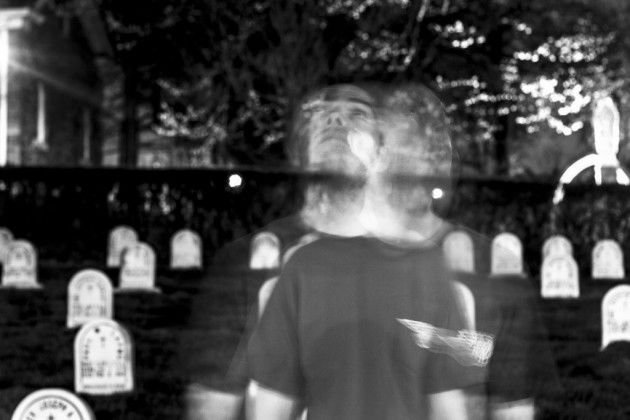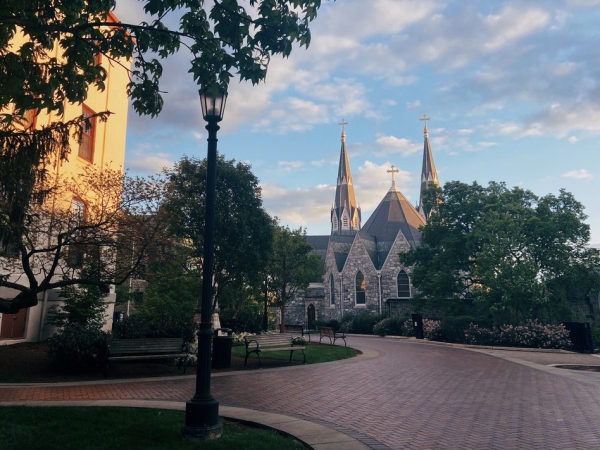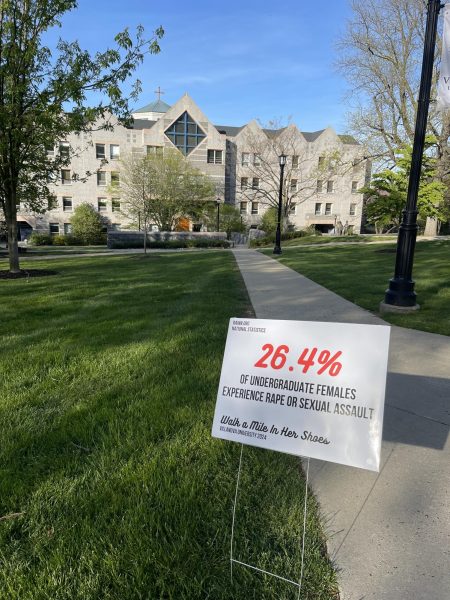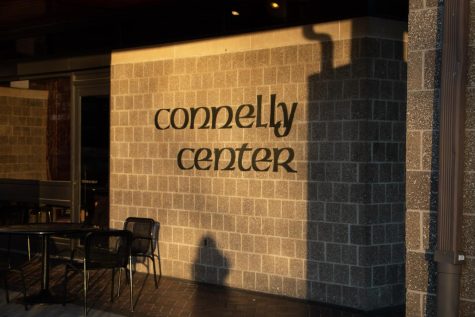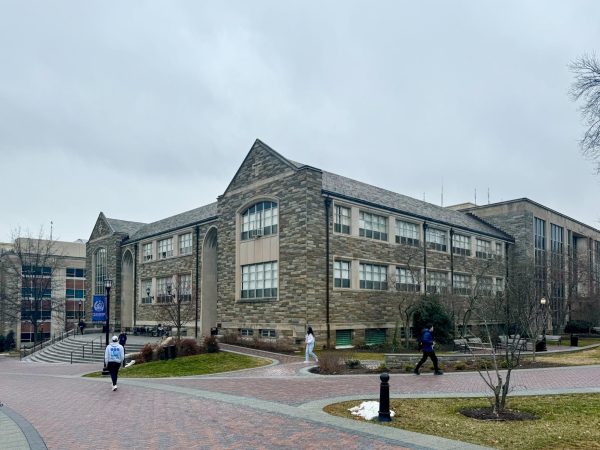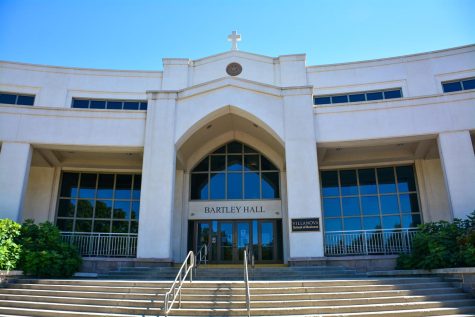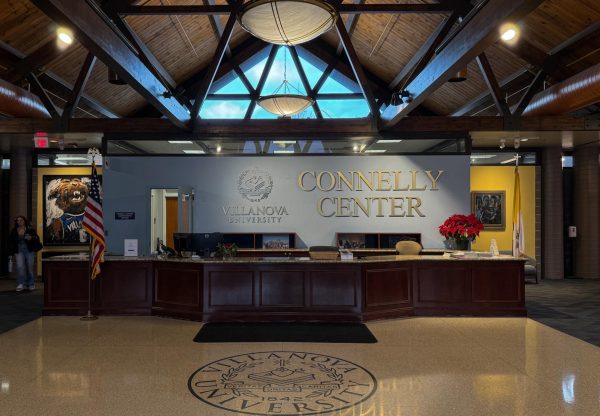An Anonymous Look into Villanova Drug Culture
April 20, 2016
Maria McGeary, Maggie Keane, Princess Garrett, Elliot Williams, Sean Doherty and Haley Millstein contributed the content that made this article possible.
Names have been changed to protect the identity of students.
As Justin stands in front of the camera that night in February, he does not smile. He does not take a second to make sure the lighting is right. He does not caption it. He does not put it on Instagram and count the number of likes it gets. Instead, he takes only one, his Radnor PD mugshot, and in it, he looks scared. His eyes glisten. His bottom lip is tucked. The bold text above it will read, “Student Arrested for LSD at Villanova.”
When the picture circulates around the internet, some recognize him from shared classes or from around campus. While he sits in a cell, his classmates sit in Connelly and speculate what his arrest means for Villanova. They list the people they know who’ve tried LSD, and wonder when they’ll see it at parties. Almost exactly a month later, another student will be escorted off by Radnor PD in connection to the LSD overdoses, but for now, the buzz grows deafening as students, faculty and staff attempt to makes sense of the incident and of Villanova’s drug culture in general.
“I wasn’t surprised, to be honest,” senior Kevin says of the episode that resulted in three arrests and three overdoses. “There’s definitely an underground drug culture here at ‘Nova.” Kevin has been smoking weed since high school, and while he admits that Villanova has everything from prescription to hard drugs, he posits that weed is the most relevant. He even goes as far to say, “Edibles,” food infused with hemp oil, “run rampant at ‘Nova.”
According to the “Monitoring the Future” survey conducted by University of Michigan, illicit drug use by college students has increased from 34 to 39 percent from 2006 to 2013. And while it’s possible that the faction of Villanova users are only surrendering to a cultural tide, that interpretation neglects to acknowledge the spectrum of choice of drug, consumption rate and motivation.
Peter, a junior, started smoking late in high school, but has never purchased weed for himself, “other than tossing in a couple bucks after we use it.” The only people he knows who’ve done LSD are from his hometown. “Some of them go to colleges that I got denied from, so it’s not like they’re degenerates or anything like that,” he says.
He has not tried LSD, or any other drug besides pot, due to a lack of opportunity, but also interest, as he feels content with smoking and drinking. While Peter is not a habitual smoker, he has surveyed his fair share of smoking culture on campus. “It definitely varies,” he concludes. “It’s not like back in the 80s when everyone who smoked wore flannels and baggy jeans.”
Junior Rebecca admits that drugs were common at her high school and that she sought them out in college. “My friends, I know that sounds so weird, we just enjoy it,” she says. “We’re not crazy. We work really hard. . . But we also enjoy smoking weed and dropping acid.” Others on campus echo Rebecca’s mentality in that they turn to drugs as an outlet from the rigorous academic and social standards of Villanova.
Few will deny the University’s competitive atmosphere, or the exclusivity many students encounter when trying to solidify their social standing. Students push themselves to be involved in several organizations and make perfect scores in their rigorous course load. They operate under the assumption that this climate makes Villanova students the best, and don’t question the sacrifices to their physical and mental health that these kinds of commitments require.
These experiences create a tempest just right to send students searching for an artificial release. This is seen in Liam, a sophomore, who smokes weed “to relieve stress and have fun,” as well as freshman Ben, who takes Adderall and smokes weed almost every day. “I can do math better when I’m high,” he explains.
Alec has smoked weed, done coke and taken acid, mushrooms, Xanax, Adderall and Vyvanse. He believes that drugs on campus are much more prevalent that one might assume, particularly Adderall, usually sought as a study aid.
Alec knows several other students that have taken LSD in the past two years and believes that the University is “very unaware” of what’s happening on campus. His declaration of the University’s insitutional ignorance punctuates the claim held by many students that administration lacks insight into the burdens that students shoulder.
Alec believes that Villanova has increased efforts to combat student drug use, particularly with the involvement of Radnor Police. Some worry that this involvement, unwelcomed by many who worry that external forces will foster misunderstanding between students and officials.
Senior Stephen has experienced first hand the effects of a misguided Radnor PD. “I had been warned that Radnor police do not have a good reputation with Villanova.” He follows this admission by telling of an experience that left him profoundly disillusioned. The story begins with a description of a brief period of his life Stephen calls, “being a stupid freshman.” This time resulted in some run-ins with Public Safety and then Dean Rost (“She’s one of the best deans we’ve ever had,” he says without a hint of sarcasm).
“Fast forward a few years, I end up getting arrested for smoking pot off campus.” Stephen was high in his car and was approached by a Radnor officer. “I’m like horrible with the cops, because in my head I’m thinking, and this is something I would’ve thought sober or under the influence of drugs, if I’m honest with this cop things are going to work out well, or better than if I try to play hardball.” Stephen soon found himself in handcuffs.
His arrest didn’t stop Stephen from smoking. He even started actively seeking out dealers to buy from post-arrest. Because of this, he does not believe the future deputization of Public Safety will do much good. “What worries me is that people get more secretive,” he says. “I think that’s everyone’s fear, that people will just become more secretive or will use drugs less often, so when they do, they feel like they need to use them more heavily.”
Six months after the incident, Stephen ran into the same officer, who was just about to tow Stephen’s car. After identifying the connection between the two, the officer began interrogating Stephen about possessing drugs. “So I have a lot of disrespect for the police around here,” he says. “For very legitimate reasons, not just because people at Villanova kind of spread that rumor.”
This is not to say, however, that Stephen’s entrance into the world of drug use at Villanova was particularly anti-establishment. Instead, he confesses to a less cynical understanding of the motivations behind it. Accepting the cliché of his words, Stephen admits, “It’s kind of cool to do drugs… especially when you’re entering freshman year and you’re trying to build a social network . . . and it becomes this cool thing to do.”
Being cool does not seem to be on freshman student Hannah’s mind. “I use Adderall even though I am not prescribed, to be more productive when I have a lot of work to do,” she says. According to Michigan’s MTF survey, 11 percent of college students in 2013, or one in every nine, indicated some Adderall use without medical supervision in the prior 12 months. Many believe this is the result of the increasingly demanding academic standards for college students. However, the drug has its uses beyond being a study aid.
“I also mix it with alcohol occasionally to be more alert and decrease the ‘sleepy effects,’ Hannah says. While some might ascribe drug use at Villanova as exclusively a social activity, or even just for stress relief, some, like Hannah, fit neither of these models. “To stop using Adderall,” she admits. “I would need my professors to lessen the amount of work they assign.”
Fellow freshman Shelby, sees drugs as neither a social tool nor a necessity for academic success. In fact, she sees no use for drugs at all and chooses to forgo using them entirely. “I didn’t do drugs in high school, so it kind of carried over,” she confesses. “I just don’t think it’s a good idea. Health and school are two big reasons, but also personal values.” On a campus where drug use seems to correlate with mounting pressures, Shelby sees drugs as a hindrance rather than an instrument of academic accomplishment.
“I have definitely seen people smoking on the Wildcat Path,” she says. “I’m like, ‘This is so bad for you. You have so many opportunities, why are you wasting them all?’”
According to senior student and VEMS member Jamie, habitual users can experience dependency, lack of interest and decline in commitment to engagements, as well as health problems associated with overdose and withdrawal. “The withdrawal process is just as debilitating as an overdose,” he says.
While Jamie has never been called to assist someone OD’d on weed (“You can’t overdose on pot,” he says. “Well, you can but it’s not physically possible to smoke that much pot.”), and hasn’t seen anything like the recent LSD incident in his four years on VEMS (“I don’t know who decided that LSD is going to be the hip drug to do, so that was unique.”), he has encountered his fair share of Adderall overdoses. “Someone who overdoses on Adderall is very different from someone who has had alcohol and did some cocaine,” he says. “I’ve had a decent amount of [patients] binging on Adderall. Their heart rate is through the roof. Their blood pressure’s up. They think they’re having a heart attack.”
He remembers a particularly chilling incident where he arrived to find a student lying on the ground outside of their building with crushing chest pain. He had taken a significant amount of un-prescribed Adderall over a 48 hour period while studying. Jamie admits that these kinds of calls are not uncommon on or around finals weeks.
And yet, Adderall is not at the forefront of the war on campus drugs. Associate Director of Public Safety Debra Patch has been at the University for 20 years and says, “Predominantly small amount use of marijuana seems to be probably the more common that we experience.” That doesn’t mean, however, that she is unaware of a few other cases of more serious drug use. Public Safety, according to Patch, takes very seriously drug use on campus, regardless of the substances involved.
“Standard practice is to hold students accountable,” Patch says. “If they are experiencing drug abuse, they’re certainly going to be referred to resources and intervention to assist them.” She describes more serious consequences for sources and distributors of drugs. Patch says these cases are either handled to campus discipline or are referred to Radnor PD, as was what happened with the LSD incident.
However, even with police intervention brooding in the minds of all student users, further developing with the upcoming transition and arming of Public Safety, Patch understands the minimal influence threat of police action has over student decisions. “I don’t know that the drug usage changes or people change their behaviors based on the fact that there’s police,” she says.
Patch’s tone towards drug use on campus, a tone of concern, echoes that of other offices of university administration, including Assistant Dean of Students, Nick Tumolo, who oversees all reported violations of the Code of Conduct.
“I think even one case of drug use is a serious issue,” Tumolo says. He admits that there are students using drugs on campus, though it is by no means a widespread epidemic. He describes the majority of violations that come through his office as alcohol related. Of the drug violations, he says most of them are marijuana related.
Personally, I felt sad. I was very sad that those things happen at Villanova because I know that we are better than that.” Tumolo says of the February incident.
“At the end of the day, this is an academic environment of excellence and drugs do not belong in an academic environment,” he says. “We know we can rise above things like drugs, and they have no place in this community.”
Tumolo cites several on-campus resources available for students, like the Assistant Dean for Alcohol and Drug Intervention, the Office of Health Promotion and the Counseling Center.
Most students, however, are not eager to seek out these resources. Certainly not juniors Emily, Jessica and Rachel, best friends and roommates who chose to be interviewed together. They all smoke pot habitually and spend about $200 for about 2 ounces of weed a month. They have forgone finishing homework tonight to smoke (“It’s no different than someone else choosing to sit in their bed and watch Netflix instead of doing their work,” Emily says.) and reminisce.
“My roommate was in the same orientation group with a kid who smoked,” Rachel says. “Every so often he texted us to go and smoke by the train tracks so that’s what happened. Every time the train went by you had to take a hit.”
“I definitely was wondering how I was going to smoke in college,” Emily says. “I came with an eighth of weed, my bowl and knew I would just figure it out.”
Emily says smoking makes her feel happier. Jessica feels like she needs it. Rachel likes to smoke before she goes out to get “amped.”
Beyond weed, Emily tried cocaine for the first time her sophomore year at a social function. “I always wanted to try it and came up with this idea to surprise this guy I had a crush on with it,” she said. “I knew he would want it, and he had done it before.”
Jessica had planned to try cocaine with Emily, but instead took the opportunity when she was visiting a friend at another school. “We had been talking about it for a while that wanted to do it and it was just the first opportunity I had to do it where it was just in front of me,” she says.
Rachel tried it her freshman year with friends from home at a party. “Someone was like ‘[Rachel], want to try some blow?’ And I said ‘Sure.’”
All have extensive knowledge and experience with drugs on campus, and yet even so, when the students were arrested for LSD, they were all surprised. “I was shocked,” Emily said. “I think it’s hilarious, but, like, that’s crazy that that was going on behind the scenes. In certain areas and schools I guess, but not Villanova for sure.”
In some ways, Emily’s comment illustrates the paradox of Villanova’s “drug culture.” No one expects students at Villanova to do drugs, not even students at Villanova who do drugs. This reflects the University’s greater culture of elitism. To be surprised by the recent LSD incident, one must believe that students here are better than drugs, just because they go to Villanova. And while there certainly does not seem to be a pervasive problem on campus, it is the impossible standards students hold themselves to that pushes them to drug use in the first place.
CAROLINE FOLEY / THE VILLANOVAN

